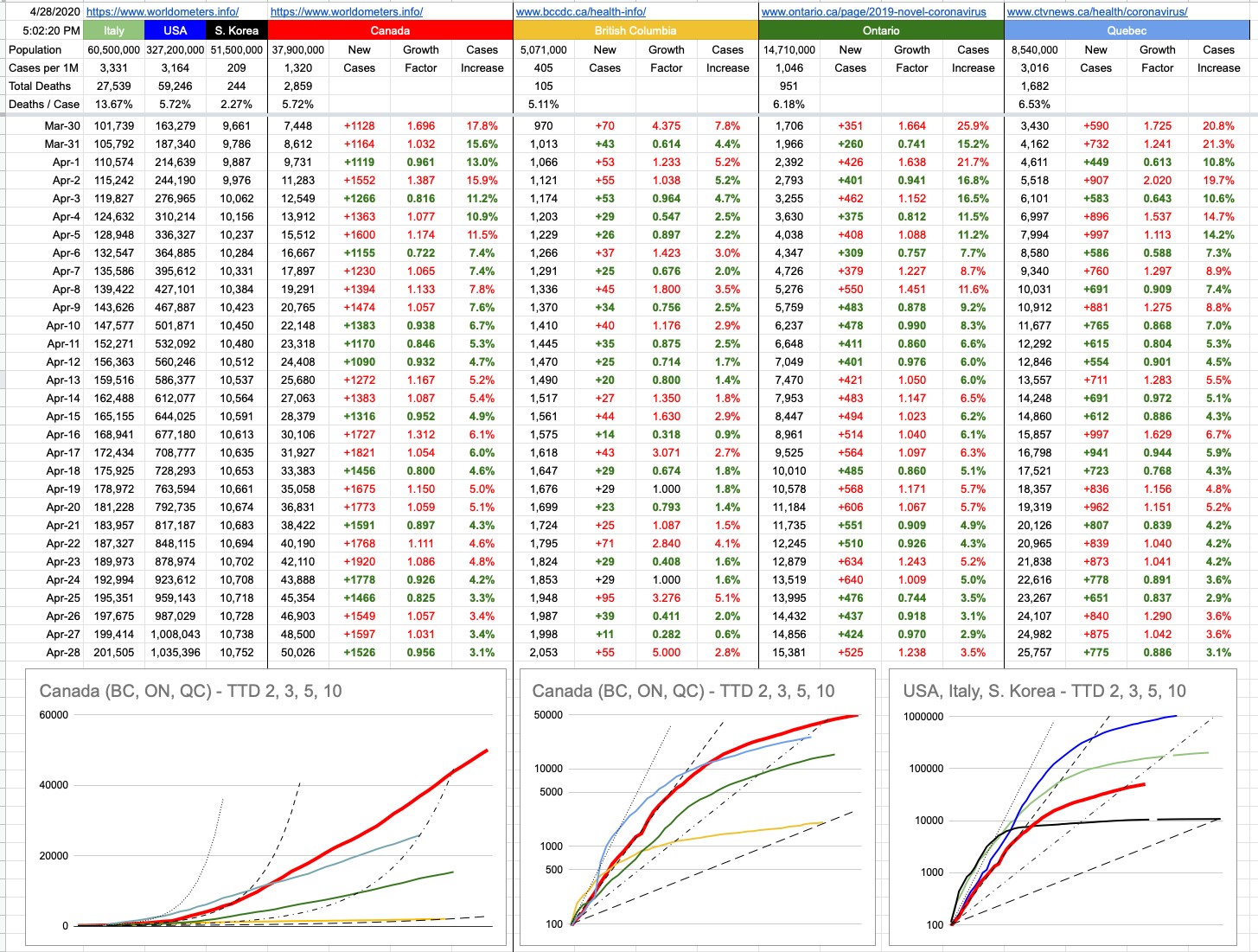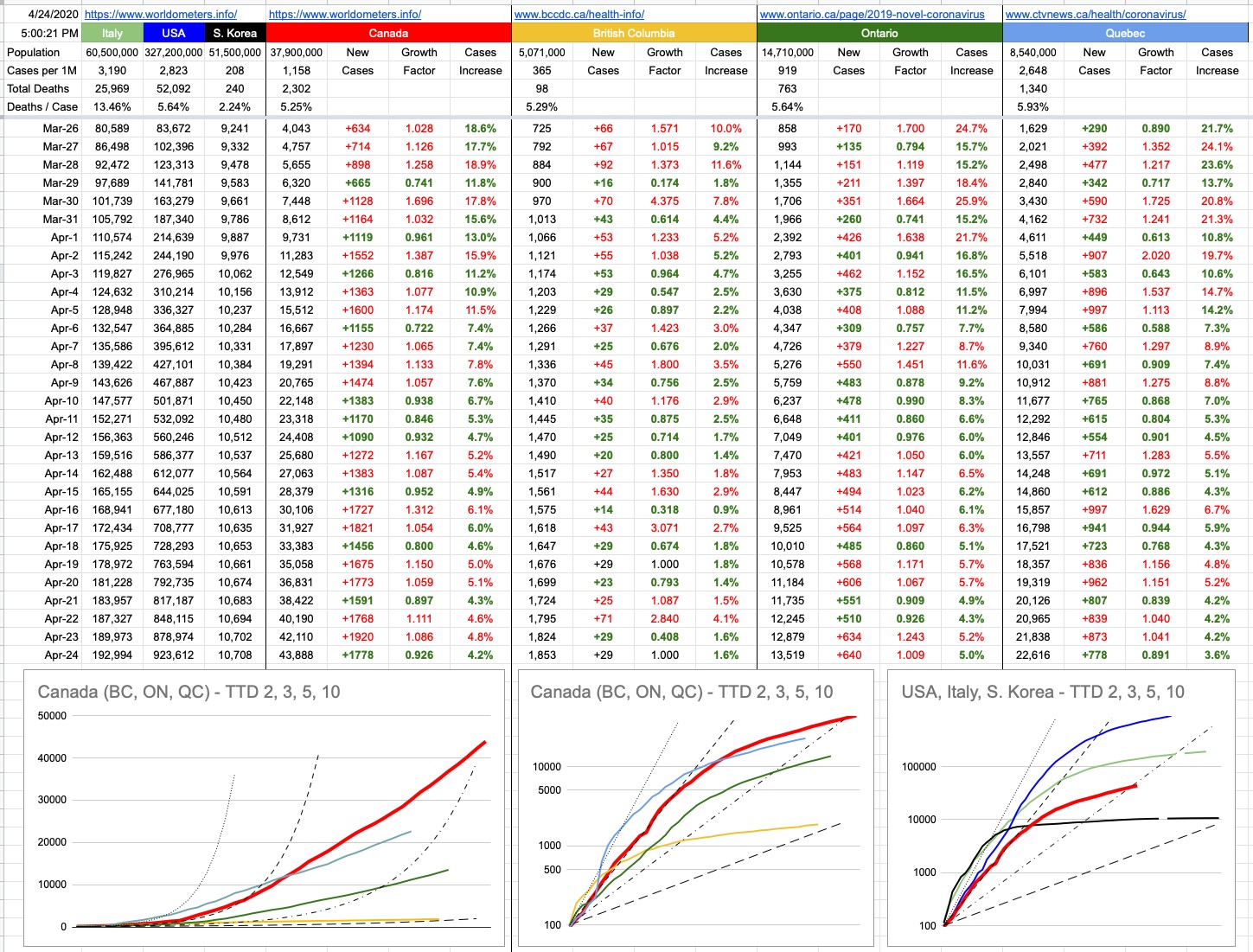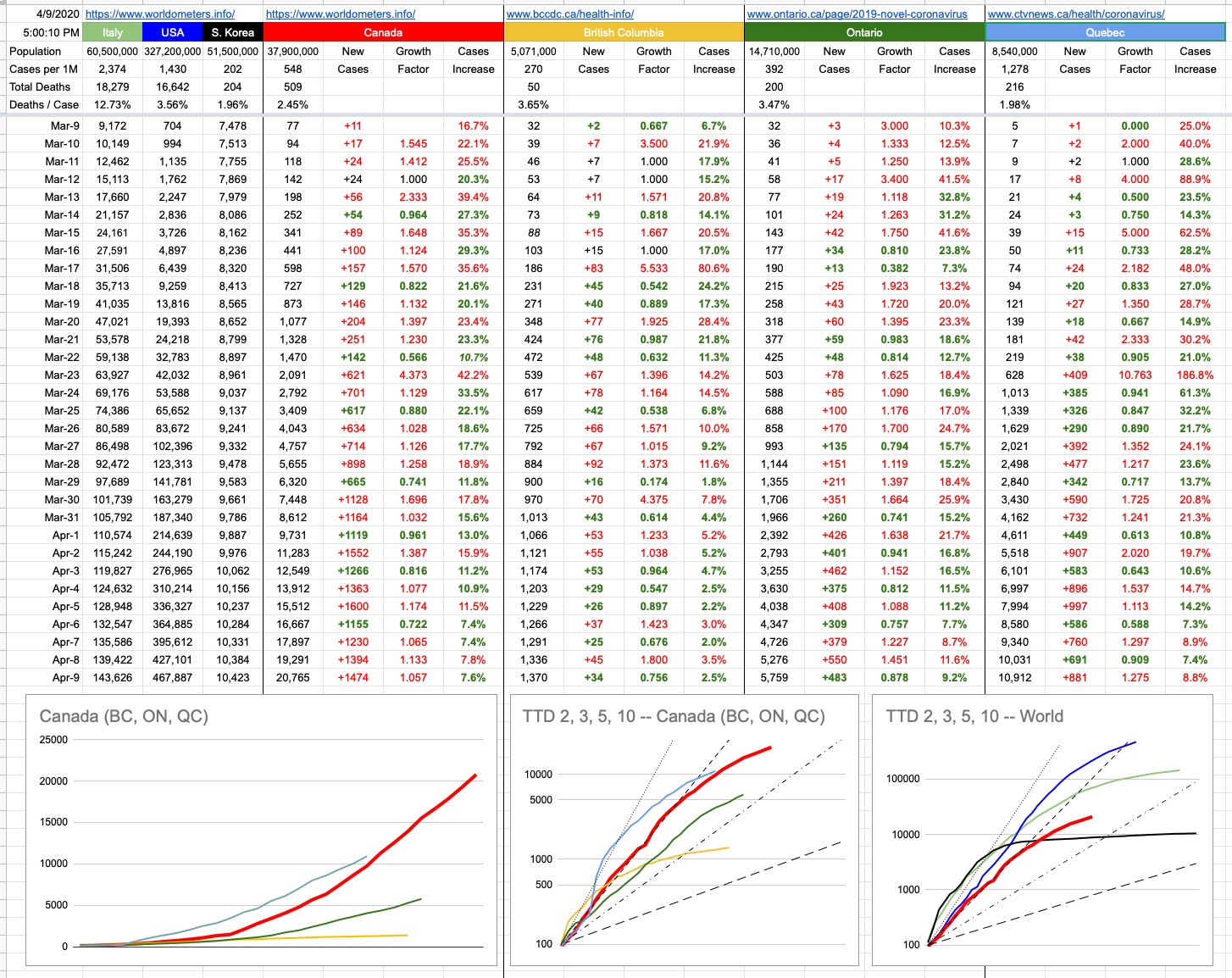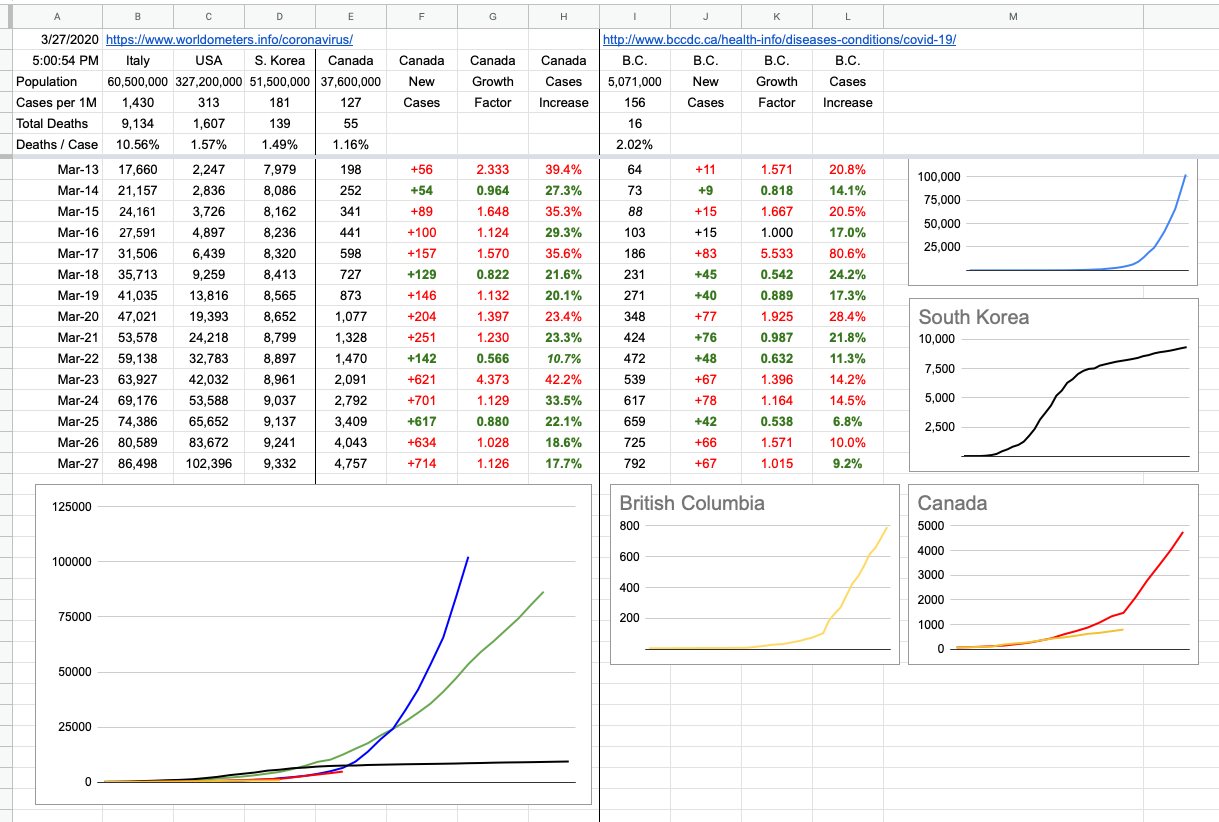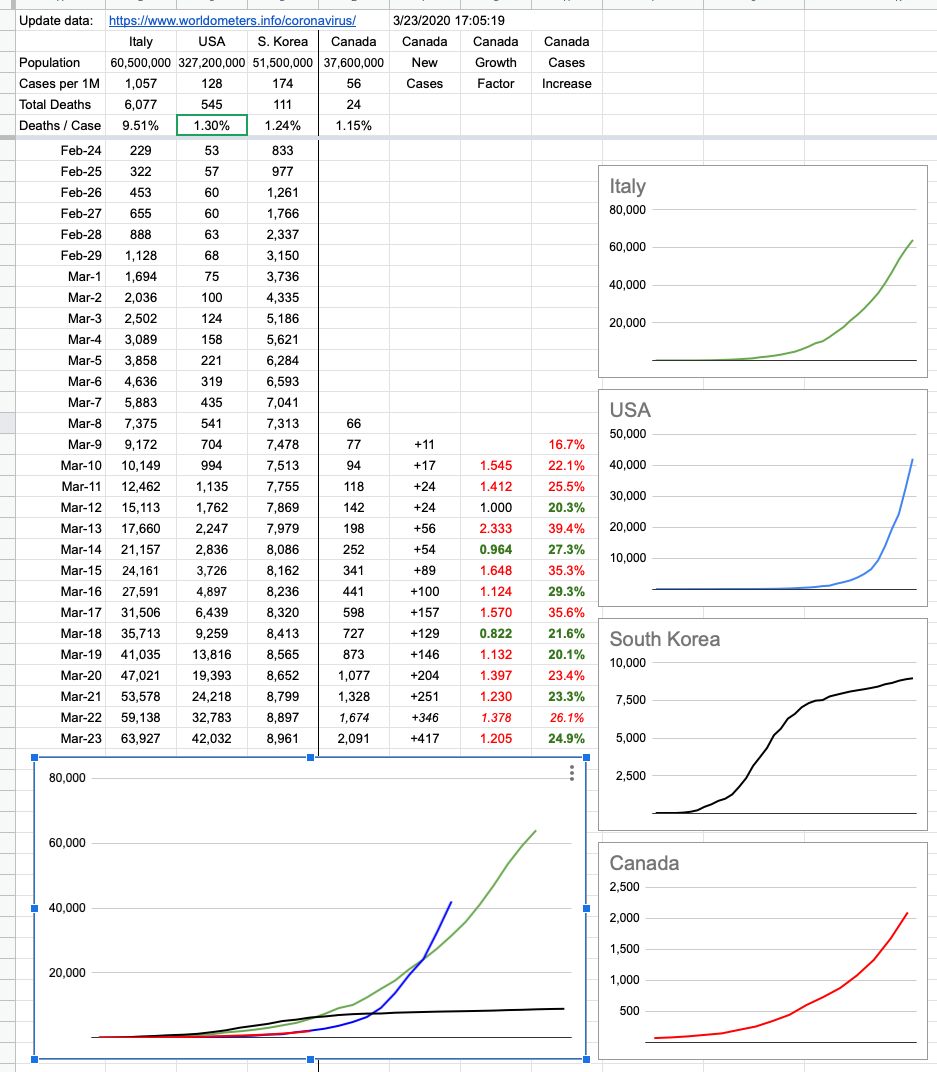Day 43 – April 28, 2020
Our local numbers shot up a bit today, but it’s a lot less concerning that in might have been a month ago, because we know exactly where and why this is happening… almost entirely due to known clusters playing themselves out — and play themselves out they do… some clusters have vanished, some care homes are down to zero and, for the most part, we have a really good handle on things. Things are on their way to re-opening.
Let’s also talk about some different numbers today, and what they imply.
In general, people talk about the stock market being up or down. Also, in general, it’s well understood that it’s good when the market is up, and and bad when it’s down. How does that apply to what’s going on these days?
First of all, let’s quickly define what we mean by “the market”. Everyone has heard of “The Dow”, and how it goes up and down.
The Dow (which refers to the Dow Jones Industrial Average — which is important to note, because there are other “less famous” Dow Jones averages) is an index that tracks, in real-time, the stock prices of a variety of big American companies, including Apple, McDonald's, Exxon, Boeing, Pfizer, Nike, Visa,, Walmart and Coca-Cola. That’s a little cross-section of the bigger mix… a variety of big industry. There are 30 companies that comprise the index, and you have heard of all of them. They are industry leaders, and how they’re doing is a reflection on the economy as a whole, at any given moment. On some days, when things are good and everything is way up, and the Dow will reflect that. Or the opposite, of course.
Today is a good day to use as an example, because it’s a mixed bag. Technology stocks (Microsoft, Apple, Google, Facebook) are all down. Financials (JP Morgan, Bank of America, Morgan Stanley, American Express) are all up. Consumer retail shares are a mix (Walmart, Proctor & Gamble are up, Amazon is down). Telecomm is also mixed bag (AT&T is up, T-Mobile is down, Verizon is flat).
Average it all out today, and the Dow is up… a little bit. There are other indexes to look at; the S&P 500 is the next most-commonly known, and it has a broader inclusion of the top 500 listed companies. It’s perhaps the best representation of the market as a whole. It’s also up a little today. Its little cousin, the S&P 100, which lists an arbitrary sample of those 500, is slightly down today.
At any given moment, what defines the price of an individual stock? It’s the equilibrium point where at that exact point in time, someone thinks buying those shares at that price is a good idea… while someone else thinks it’s the right time and price to sell. And these days, that someone is just as likely to be a big, intelligent computer.
Tens of thousands of shares are being traded every second, so when things get quiet (from a broad market price point-of-view), it’s an interesting oasis of calm before the next storm. Like, briefly, for a moment, everyone knows where things are at. Or, think they do…
Imagine you’ve been sitting on a little seesaw in the park, quietly enjoying smooth ups and downs with your friend. Suddenly, instantly, the seesaw grows to 20 metres long… and your friend is replaced by some gigantic bully that seizes his end of the seesaw and starts slamming it up and down, as hard as he can. You hold on for dear life, understanding that jumping off may hurt you more than just hanging on… and you just hope this giant jerk will eventually tire and go away, hopefully leaving you gently on the ground. This is what it’s felt like to be an investor these days.
The all-time high for the Dow was recent… before things came crashing down. On Feb 12th, the Dow closed at 29,551. From there began a bumpy ride that saw it lose 5,000 points over the next couple of weeks, before bouncing back up a bit. Then, in early March, all hell broke loose, and the wild swings of thousand-point gains and losses began, bottoming out at the lowest of lows, hitting 18,214 on March 23rd. And from there, it shot-up to 22,500. It’s presently sitting at 24,100… still well-off the high, but also significantly higher than that bottom. A 20% “off the high” is still alarmingly awful in such a short time, but it’s twice as good as the 40% bottom from a month ago.
Many people are saying it shouldn’t have dropped that far. Many are saying it should have dropped a lot further, and still could. Many are saying there’s no reason it should have recovered this much already. As per above, for everyone who thinks it should be higher, someone else thinks it should be lower. Those two people are presently buying/selling to/from each other, and that’s why it’s exactly where it’s at.
What caused these drastic moves? Unexpected news, rumours, fear… and, of course, real-world disclosures regarding the long-term effects of shutting down significant parts of the economy. And everyone absorbing that information, independently interpreting it and acting accordingly.
When things move that quickly, it rarely has anything to do with fundamentals. Nobody is looking at price:earnings ratios or dividend streams… more like trying to figure out market sentiment and just riding it out till things settle down.
At some point, when it’s fallen that far, a bounce is not just expected, but possibly predicted. The technical traders — those who care nothing about underlying companies but just analyze the numbers themselves… they love to pick resistance points… and identify trends in the market by when prices bounce off a price, or power through it. One of the most famous ones is based on the Golden Ratio — a relationship found all over nature. Flowers, pine cones, sea shells, dolphins, penguins… all have proportions and other fundamental constructs based on it. The magic numbers there are 61.8% and its converse, 38.2%… and whenever a market tanks, the first thing to look for is a “bounce off the 618” — which is exactly what happened to the Dow in my example above. Which further leads me to accurately assume that really, nobody knows what’s going on fundamentally, so when trying to figure out when to buy back in, “let’s just go with that”. When the Dow hit that 618 retracement, a lot of buying stepping in.
There is another index… it’s called the VIX… and if you Google VIX, you can instantly pull up a chart of it and how it looks. The VIX measures volatility, ie just how wildly things are swinging. The bigger the number, the wilder the ride.
The VIX never broke 20 in all of 2019… like you and your friend on the seesaw, quiet ups and downs. When the insanity began last month, that VIX shot up and broke 80 at one point, and has consistently been over 50 most of March. It’s recently started coming down, which is optimistically implying that things will settle down, at least to the point where maybe there’s some idea of what’s really going on. Call it cautious optimism as places start opening up and life shows some promise of taking its first steps towards normality.
And that’s market sentiment in a nutshell — nobody knows. Especially these days. Even in the best of the quietest times, there are always people on both sides of the seesaw. But the level of “unknown” these days is unprecedented… but I will tell you this, with certainty. The market will be hitting new highs… when? I don’t know. I will say September of 2022. But it could also be a lot sooner than that. Or, it could be a lot later. See what I mean?
View Original Post and All Comments on Facebook


